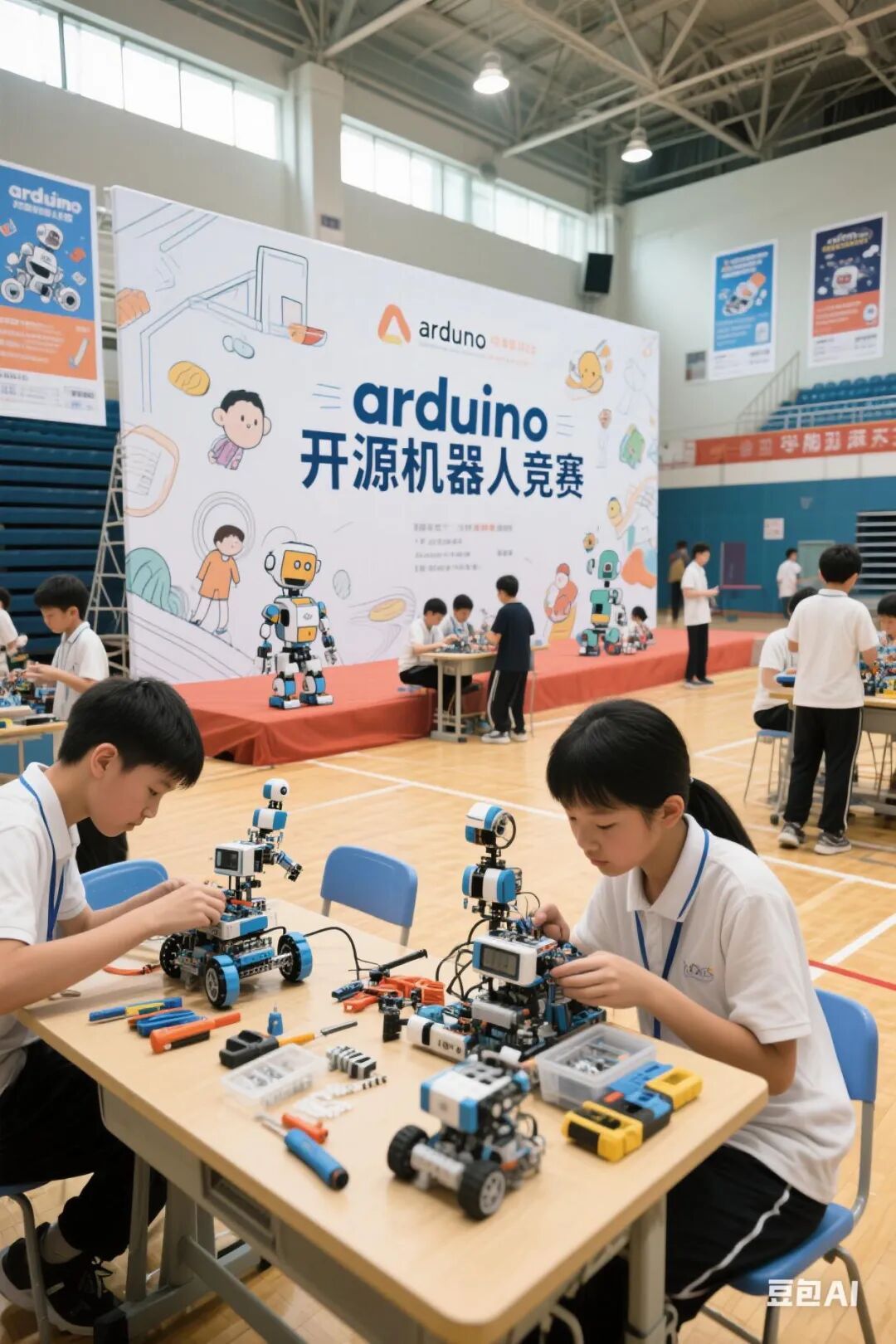The following is a detailed plan for the design of an Arduino-based open source wheeled robot competition at the school level, covering competition objectives, rules, task design, scoring criteria, and implementation processes, suitable for the ability cultivation and selection of students in compulsory education.
### **1. Competition Objectives**
1. **Technical Literacy**: Master the basics of Arduino programming, sensor applications, and mechanical structure design.
2. **Innovative Ability**: Encourage students to propose creative solutions when solving practical problems.
3. **Team Collaboration**: Complete complex tasks through division of labor and cooperation.
4. **Scientific Thinking**: Cultivate an engineering problem-solving process (design – test – iterate).

### **2. Competition Rules**
#### **1. Hardware Limitations**
– **Main Control Board**: Uniformly use Arduino Uno/Nano (to avoid performance differences).
– **Sensors**: Common sensors such as infrared, ultrasonic, color, and gyroscope are allowed (limited to 3 types).
– **Actuators**: DC motors (no more than 4) or servos (no more than 2), the use of finished servo gimbals is prohibited.
– **Structural Materials**: The main body must be made of open-source 3D printed parts or handmade materials (such as wood, acrylic), and fully enclosed finished chassis are prohibited.
#### **2. Software Limitations**
– Programming Language: Arduino C/C++ or Mixly graphical programming (divided by grade groups).
– The use of pre-trained AI models or remote control is prohibited; the robot must operate autonomously.
#### **3. Group Settings**
– **Elementary Group (Grades 4-6)**: Tasks simplified, graphical programming allowed, focusing on basic functionality.
– **Middle School Group (Grades 7-9)**: Code programming required, with added algorithm optimization and creative extension requirements.

### **3. Competition Task Design**
#### **Task 1: Basic Challenge (Mandatory, 60 points)**
– **Track Environment**: A closed tracking route laid with black tape (including right-angle turns, S-bends, and disconnection areas).
– **Core Requirements**:
– The robot must complete 3 laps of tracking within 2 minutes, and if it derails, it can be manually placed back (points deducted).
– The middle school group must automatically switch to ultrasonic obstacle avoidance mode in the disconnection area to continue forward.
#### **Task 2: Obstacle Transport Challenge (Optional, 30 points)**
– **Scene Setup**: Set up a “Material Area” (to place lightweight building blocks) and a “Target Area” next to the track.
– **Challenge Objective**:
– The robot must identify the location of materials during tracking and use a mechanical arm or push plate to transport 3 blocks to the target area.
– The middle school group must classify and place blocks by color (requires a color sensor).
#### **Task 3: Creative Design Challenge (Additional, 10 points)**
– **Free Topic**: Students can add one extension function to the robot (such as voice prompts, lighting effects, environmental monitoring, etc.).
– **Scoring Criteria**: Innovation, completeness of technical implementation, relevance to the theme (e.g., “Smart City Rescue” theme).
### **4. Scoring Criteria**
| **Scoring Dimension** | **Details** | **Score Ratio** |
|——————–|—————————————————————————–|————–|
| **Task Completion** | Number of tracking laps, number of transported blocks, success rate in handling disconnection areas | 50% |
| **Time Efficiency** | Total time taken to complete tasks (points deducted proportionally for exceeding time) | 20% |
| **Innovation and Complexity** | Mechanical structure design (e.g., steering mechanism), algorithm optimization (PID control), practicality of additional functions | 20% |
| **Team Collaboration and Defense** | Reasonableness of division of labor, ability to solve on-site debugging issues, clarity of defense presentation | 10% |
### **5. Implementation Process**
#### **Stage 1: Pre-Competition Preparation (2 months)**
– **Technical Training**: Organize 3 internal workshops covering:
– Basics of Arduino and sensor connections (2 hours)
– Motor control and PID tracking algorithm (3 hours)
– Mechanical structure design and introduction to 3D printing (2 hours)
– **Material Distribution**: Provide basic kits (including Arduino, motors, wheels, sensors), allowing the purchase of additional modules.
#### **Stage 2: Registration and Proposal Submission (1 week)**
– Each team consists of 2-3 members, submitting a robot design sketch (indicating sensor positions) and a functional description document (within 200 words).
#### **Stage 3: On-Site Competition (1 day)**
| **Time** | **Session** | **Content** |
|—————-|——————————|————————————————————————-|
| 09:00-09:30 | Registration and Equipment Check | Check if hardware complies with rules, pre-programmed devices are prohibited |
| 09:30-12:00 | Tasks 1-2 Competition | Each team has 3 chances to challenge, taking the best score |
| 13:30-14:30 | Creative Design Presentation and Defense | Each team has 3 minutes for presentation + 2 minutes for judges’ Q&A |
| 15:00-15:30 | Awards and Summary | Awards for first, second, and third place based on total scores, with additional awards for “Best Creativity” and “Best Engineering” |
### **6. Cost Control and Safety Measures**
– **Hardware Cost**: Control the cost of a single basic set within 200 yuan (4 motors: 50 yuan; Arduino Uno: 30 yuan; sensor set: 60 yuan; structural materials: 60 yuan).
– **Safety Requirements**:
– Use power supplies below 12V, and prohibit exposed wires.
– The mechanical arm’s range of motion must be equipped with a soft protective cover.
### **7. Case References**
#### **Excellent Plan for Elementary Group**
– **Robot Name**: “Lightning Patrol Car”
– **Design Highlights**:
– Made a detachable cargo hold from cardboard, fixed blocks with magnets.
– Infrared + ultrasonic dual sensor switching, adaptable to complex tracks.
#### **Excellent Plan for Middle School Group**
– **Robot Name**: “Smart Sorting Hand”
– **Design Highlights**:
– Homemade color recognition module, sorting different colored blocks with servos.
– Sends real-time task progress via Bluetooth from a mobile phone (requires additional HC-05 module).
### **8. Extended Value**
1. **Curriculum Connection**: Competition tasks can be transformed into school-based courses “Intelligent Robot Design and Practice”.
2. **Teacher Growth**: After the competition, organize teacher exchanges on Arduino teaching cases, establishing a regional resource sharing library.
Through this plan, students can not only experience the complete engineering development process but also cultivate resilience and innovative awareness in competition, preparing talents for higher-level competitions while promoting the integration and upgrading of school maker education resources.